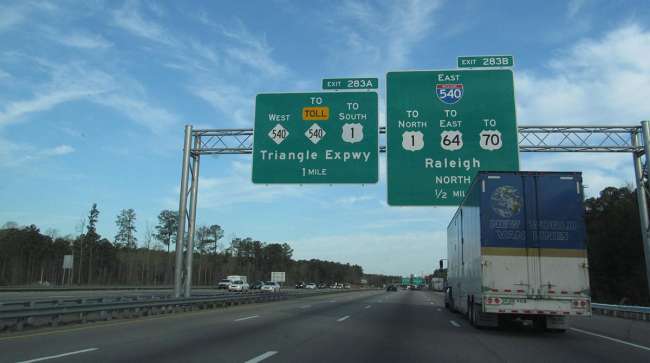Staff Reporter
NCDOT Plans to Fully Reopen Stretch of I-40 by Christmas

Travelers using Interstate 40 to pass through Raleigh, N.C., can expect lanes that have been under construction for the past few years to be restored by Christmas, according to North Carolina Department of Transportation Spokesman Steve Abbott.
NCDOT’s goal is to finish repaving an 8.5-mile stretch of I-40 before the end of the year, Abbott said. The work is part of the department’s larger Project Fortify, a 10-year plan involving the repaving of portions of I-40 and I-440, the extension of lanes between ramps in each direction and the reconstruction of 14 bridges.
I-440 connects to I-40 at the southeastern edge of Raleigh and forms a half-loop around the city.
“The substructure of the road was deteriorating. Basically, the road was falling apart,” Abbott said. “Essentially it was tearing the road up down to the dirt and rebuilding.”
I-40 has between three and five lanes moving in each direction, depending on the section of the route. Abbott said that three lanes in each direction remained open every day during the repaving process. For portions of I-40 that have only three lanes, road crews completed one lane at a time overnight. Construction teams rebuilt the road starting from the outermost lanes, Abbott said.
One of the reasons NCDOT kept three lanes open during the day was to minimize congestion on this portion of I-40, which Abbott said sees over 140,000 vehicles a day. NCDOT conducted a public awareness campaign alerting organizations in the area that I-40 would be narrowed as it was being treated.
Abbott said that NCDOT led hundreds of meetings. Companies changed their work schedules and the public transit system set up another bus route to accommodate for the restricted space on I-40. As a result, traffic stalled to a lesser degree than NCDOT had anticipated, Abbott said.
“It’s been worse, but not nearly as bad as we had projected. If it had been two lanes, people said it would have the worst impact of any project in the state,” Abbott said. “The biggest impact has been less than we anticipated. We anticipated a half hour delay through the 8.5-mile stretch. That never materialized, and we think it’s because a lot of people altered their schedules.”
One of the groups that helped NCDOT during this project was North Carolina Trucking Association. NCTA President Crystal Collins said the association diverted industry traffic from the work zone. Collins said she hopes the completion of this road work means that resources will be directed to other issues, such as increasing the availability of truck parking spaces.
“The completion of the I-40 project by NCDOT will increase mobility to the trucking industry along the corridor. An integral part of the transportation industry, this stretch of road connects North Carolina ports to the rest of the state via the I-40 artery,” Collins said. “With the project complete, trucking industry members will be able to utilize the completed improvements more fully and have more time predictability.”
Road teams are working behind Jersey barriers as they repave I-40. When they complete a segment, plastic traffic barrels replace the concrete barriers. According to Abbott, travelers have felt so liberated by the absence of the Jersey barriers that a number have been caught speeding down the newly paved interstate.
“Three weeks ago, we caught 17 drivers going 80 [miles per hour] and above through the work zone. One was doing 95. It’s so smooth. You’re essentially on a brand new interstate for 8.5 miles, and people are flying,” Abbott said. “People have been in construction traffic for three years and they finally have freedom. For three years, there were Jersey barriers. People are enjoying the freedom a little too much.”
I-40 is an important route for trucking. Collins cited a study from North Carolina State University stating that 30% of traffic from the trucking industry occurs at the six-mile junction between I-40 and I-95.
Furthermore, I-40 is crucial because it links many cities in the state to the Port of Wilmington, Abbott said. According to the Port of Wilmington’s website, the port’s cranes deliver more than 45 moves an hour, and truck turnaround times average 18 minutes for a single move. Abbott said I-40 also links to other major routes, such as I-85 and I-77.
“It is a huge route for freight movement. If you’re trucking things out of the port of Wilmington to Raleigh, to Charlotte, to Winston-Salem, that’s the route you take,” Abbott said. “So many trucks are traveling on that road. If you’ve got goods that you want to ship out, you’re going to Wilmington this way.”




